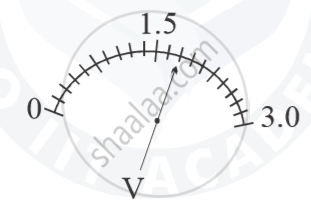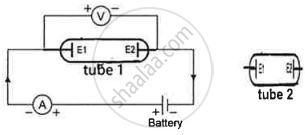Advertisements
Advertisements
Question
Calculate the electric field in a copper wire of cross-sectional area 2.0 mm2 carrying a current of 1 A.
The resistivity of copper = 1.7 × 10–8 Ω m
Solution
Given:-
Area of cross-section, A = 2 × 10–6 m2
Current through the wire, i = 1 A
Resistivity of copper, ρ = 1.7 × 10–8 Ωm
Resistance of a wire,
\[R = \rho\frac{l}{A}\]
Also from Ohm's Law, voltage across a wire,
\[V = iR = \frac{i\rho l}{A}\]
The electric field of the wire,
\[E = \frac{V}{l}\]
Now:
`R = (fl)/A`
`= (1.7xx10^(-8)xxl)/(2xx10^-6)`
`V = iR = (1 xx1.7xx10^-8xxl)/(2xx10^-6)`
`E = (dV)/(dL) = V/l`
`= (1.7xx10^-8)/(2xx10^-6`
`= 1.7/2xx10^-2`
`= 17xx10^-3`
`= 8.5xx10^-3`mv/m.
APPEARS IN
RELATED QUESTIONS
If the potential difference across the ends of a conductor is 220 V and the resistance of the conductor is 44 Ω (ohm), then the current flowing through is _________.
- 0.2 A
- 0.5 A
- 2 A
- 5 A
Find the resistance of a conductor if 0.24 A current is passing through it and a potential difference of 24 V is applied across it.
Will current flow more easily through a thick wire or a thin wire of the same material, when connected to the same source? Why?
What is an Ohmic resistor?
When a 12 V battery is connected across an unknown resistor, there is a current of 2.5 mA in the circuit. Calculate the value of the resistance of the resistor.
Ohm's law gives a relationship between:
(a) current and resistance
(b) resistance and potential difference
(c) potential difference and electric charge
(d) current and potential difference
Keeping the p.d. constant, the resistance of a circuit is halved. The current will become:
(a) one-fourth
(b) four time
(c) half
(d) double
How much energy is consumed when a current of 5 amperes flows through the filament (or element) of a heater having resistance of 100 ohms for two hours? Express it in joules.
- Draw a V-I graph for a conductor obeying Ohm’s law.
- What does the slope of V–I graph for a conductor represent?
Which of the following is an ohmic resistance?
Calculate the current flowing through a wire of resistance 5 Ω connected to a battery of potential difference 3 V.
Show by a diagram how two resistors R1 and R2 are joined in parallel. Obtain an expression for the total resistance of the combination.
Consider the sacle of voltmeter shown in the diagram and answer the following questions :

(a) What is the least count of the voltmeter?
(b) What is the reading shown by the voltmeter ?
(c) If the voltmeter is connected across a resistor of 20 `Omega` how much current is flowing through the resistor?
Define the following:
(i) Coulomb
(ii) Ohm
- Name and state the law which relates the potential difference and current in a conductor.
- What is the necessary condition for a conductor to obey the law named above in part (a) ?
The unit of specific resistance is ____________.
A student carries out an experiment and plots the V-I graph of three samples of nichrome wire with resistances R1, R2 and R3 respectively. Which of the following is hue?

Assertion: The statement of Ohm’s law is K = IR.
Reason: V = IR is the equation which defines resistance.
State Ohm's Law. Represent it mathematically.
The circuit depicted in the figure is employed for studying Ohm's Law. Instead of using a standard resistor, a student opts for a glass tube filled with mercury (tube 1), connected to the circuit through two electrodes E1 & E2. He records the readings of the ammeter and voltmeter, thereby calculating the resistance. The student repeats the experiment by substituting tube 1 with tube 2, where the same amount of mercury fills the tube 2.

Neglecting internal resistance of the cell use (> or < or =) to compare
- the resistance in both the cases.
- the voltmeter readings in both the cases.
- the specific resistance in both the cases.
